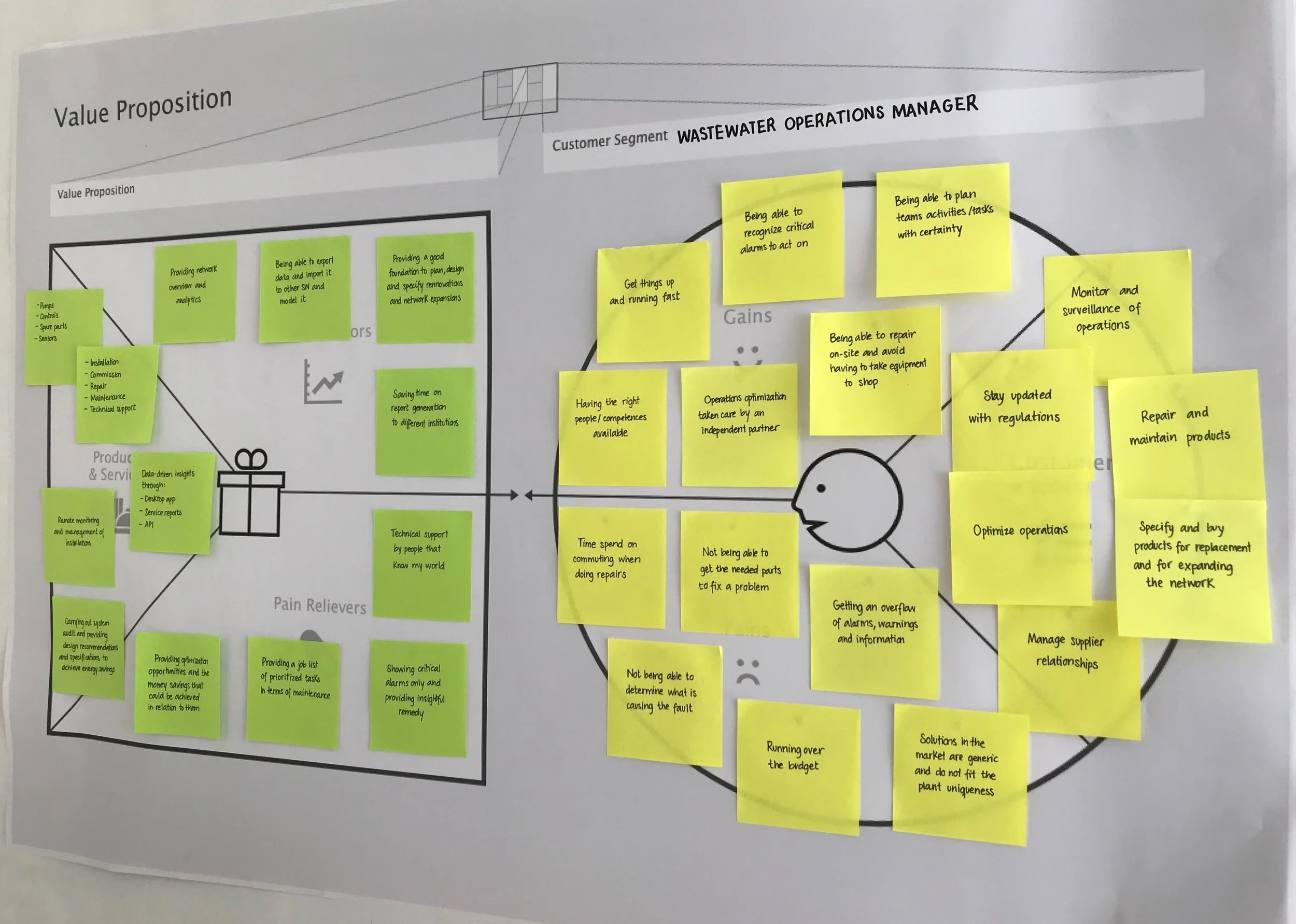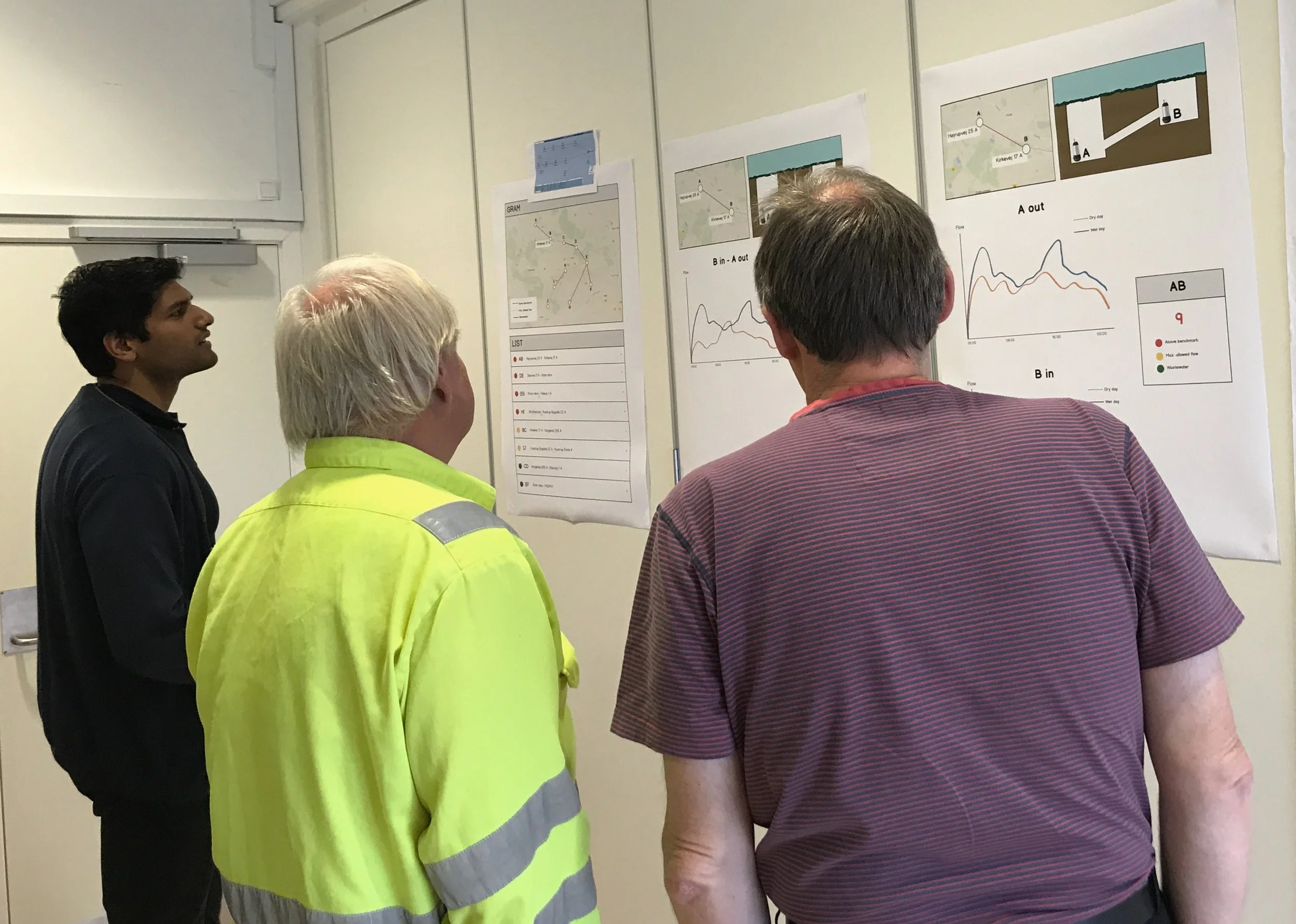
Co-creating digitally enabled services with wastewater operators
My role Lead UX Designer
Activities User research, personas, user journey maps, ecosystem map, storyboards, co-creation workshops, hackathons, wireframing, prototyping, usability testing, service roadmap, user stories writing, quality assurance
Client Grundfos
Sector Utilities, Sustainability
Duration 1 year
Challenge
Poorly managed sewage networks lead to wastewater being discharged to the environment with devastating results. The proper use and management of water is crucial to our future. In running wastewater networks, operators face an increasingly challenging business landscape subject to an ageing infrastructure, a growing population, a retiring work force, increasing regulations, climate change implications, etc.
While modern sensor technology and data driven applications can clearly add great customer value to this industry, it becomes crucial to research and design them for the human environments in which they are embedded to ensure their effective integration and success.
Outcome
In partnership with a Danish water utility and together with a cross-functional team, we designed and develop a data driven MVP supporting wastewater operators and planners run and optimize sewage networks daily management, infrastructure planning and design.
Process
Research
To begin with, I planned and facilitated several internal workshops with key stakeholders. These allowed us to harvest the knowledge and experience from water utility business developers, application specialists and different regions’ sales and service personnel.
I also participated on in-field visits to water utilities in Denmark, Portugal, Poland and Germany to meet end-users and their world. This was key for getting a first-hand understanding of wastewater operators’ daily work, their needs, pains, and the challenges they face.
Synthesis
Following every research activity, I distilled and captured key insights, and iteratively built different visual representations about the end-users and their ecosystem. I conducted a socio-cultural, technological and economic trend analysis of the European water utility industry to identify challenges and map tendencies within it. I created ecosystem maps capturing all the key roles that had an influence on the identified users, their organization and service environment.
I built personas for the identified users and storyboards documenting the pains that needed to be addressed with the service offerings.
Along the course of the project, all these maps and representations were key to facilitate and speed up communication efforts with all work streams in the team, as well as for design and development activities.
Co-creation
I planned and facilitated co-creation workshops with business developers and wastewater operators and planners. By translating ideas into visual concepts and paper prototypes we tested and validated hypothesis and incorporated them as learnings in the service offerings.
Hackathons
I also helped in the planning and organization of hackathons to help address key challenges distilled along the way. Here, I had a very close collaboration with data scientists in the team. I exchanged inspiring user insights with them towards arriving at valuable data visualizations.
I also worked on understanding their data-driven graphs as a result of their analytics process and integrating them into the concepts in a user friendly way. Working together with data scientists through data visualizations and all their details proved to be crucial when conducting show and tell activities with end-users, so that they could relate to real system data.
UX design
As we arrived to a clear conceptual understanding of the offerings, I collaborated with digital designers handing over detailed wireframes for the production of visual design. This work also involved a collaboration across digital projects in the company towards aligning and building a consistent and scalable design system for Grundfos’ cloud platform.
I built clickable prototypes that I proactively tested with end-users to gain insights and determine how to improve the designs. Besides these clickable prototypes, having a real data truly disposable prototype provided by data scientists was key to test out the concepts and gather feedback while being able to substantially change the prototype in a few hours.
Implementation
As the iterated design was ready, I assisted writing user stories and requirements, making sure they covered all aspects of the UX concepts. I also participated in sprint planning and backlog prioritization activities towards ensuring that everybody understood the why behind the ultimate design. Owning and championing an ever-improving vision of the solution was key to ensure development efforts moved forward in the right direction and the product eventually delivering up to it.
To realize our vision, together with sales and service developers, we provided a service roadmap for a progressive development and delivery of the solution. This included the definition of the MVP for the first release, and the following necessary enhancements to achieve greater impact.
Impact
A real data-driven prototype of the first MVP was showcased in May 2018 at IFAT, the world's leading trade fair for water and sewage management. This enabled the collection of industry feedback towards the first MVP release happening later that year with several paying customers in Denmark and Germany.
Reflections and takeaways
Establishing on-going cooperation partners and pilot projects becomes key in the co-creation and co-development process of industry big data projects
In order to have something sufficiently thought through to be build-ready, when working with complex big data applications, there is a need for having tested and specified every possible scenario beforehand
Commercialization strategies are an integral part of the development work and should be well-aligned with the design and development process to ensure the offerings make sense at each release
MORE CASE STUDIES
Design research│ Service design
UX research & design

















